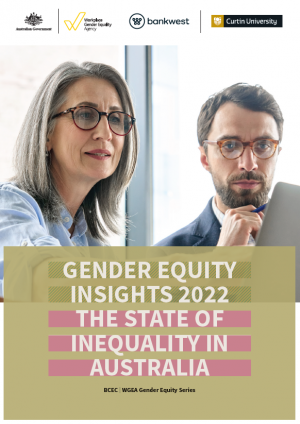Gender Equity Insights 2022: The state of inequality in Australia
Missed the online report launch? You can watch it on YouTube here.
The seventh edition of the BCEC|WGEA Gender Equity Insights series looks at Australia’s gender pay gap and finds that it could narrow by a third if a more balanced gender concentration was achieved across all industries and occupations.
Drawing on new Workplace Gender Equality Agency data, voluntarily reported for the first time in 2020-21, the report finds Australia’s gender pay gap would fall from an estimated 23.3 per cent to 15.6 per cent if a 40:40:20 gender concentration – 40 per cent women, 40 per cent men and 20 per cent any gender – was achieved across all industries and occupations.
The BCEC|WGEA Gender Equity Insights 2022 report uses the new WGEA location data to compare pay metrics, gender pay gaps and organisational practices across Australia’s states and territories as well as regional areas.
The analysis reveals the extent to which the overall gender pay gap is driven by higher concentrations of men in high salary industries and jobs, and higher shares of women working in lower salary sectors.
The report found that for Western Australia – the state with the nation’s highest gender pay gap – the gap in total remuneration would halve from 32.1 per cent to 16.5 per cent if a 40:40:20 gender balance was achieved across all industries. In the Northern Territory, the gender pay gap would reduce by two thirds, while New South Wales and Victoria would see gender pay gaps fall by 7.4 and 6.5 percentage points respectively. Queensland recorded a larger margin of 8.8 percentage points.
Key findings
- Australia’s gender pay gap could narrow by more than a third if a more balanced gender concentration was achieved across all industries and occupations,
- The gender pay gap in WA would halve from 32.1 per cent to 16.5 per cent if a 40:40:20 gender balance across all industries was achieved,
- In the NT, the gender pay gap would reduce by two thirds, from 25.3 per cent to 8.3 per cent, NSW and Victoria would see gender pay gaps fall by 7.4 and 6.5 percentage points respectively, and Queensland by a larger margin of 8.8 percentage points, from 22.5 per cent down to 13.7 per cent,
- To achieve a 40:40:20 gender concentration for industries in Australia there needs to be an increase in the share of men working in health care and social assistance, and education and training, coupled with an increase in the share of women working in construction, mining, manufacturing, information services, transport and wholesale services,
- There also needs to be an increase in the share of women in leadership positions from CEO through to executive manager, technicians and trades workers and operators and drivers, and a rise in the share of men working in community and personal service occupations, sales positions, and clerical and administrative services,
- WA has the biggest gender pay gap in the nation, coming in at 26.8 per cent for base salaries and 32.1 per cent when considering other factors such as bonuses, overtime and discretionary pay,
- For most states and territories, the overall gender pay gap is not caused primarily by salary differences between women and men within specific industry sectors. In most cases, the main driver is instead the high concentration of men in higher salary sectors and women in sectors with lower pay, especially in WA, Queensland and the NT,
- For people working in major cities of Australia, the gender pay gap in base remuneration is around 19 per cent. However, the gender pay gap rises steadily to 28.2 per cent for those working in remote areas, and to 29.3 per cent for workers in very remote parts of the country,
- Women working in remote Australian communities are impacted the most, with men being paid an estimated $17, 800 more than women,
- Women in certain industries, such as construction, health care and education, were more likely to experience gender inequality as they got older,
- Women working in the construction industry were more likely to experience a higher gender pay gap at the age of 45, compared to 20 years of age,
- Women aged 55 and over face larger differences in remuneration than their male contemporaries, compared to younger cohorts,
- Businesses should ensure that all policies and practices related to recruitment, retention and promotion are conscious and consistent in promoting a greater equality of opportunity for women in securing roles across all industries.






